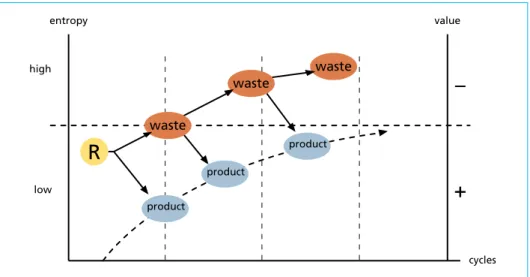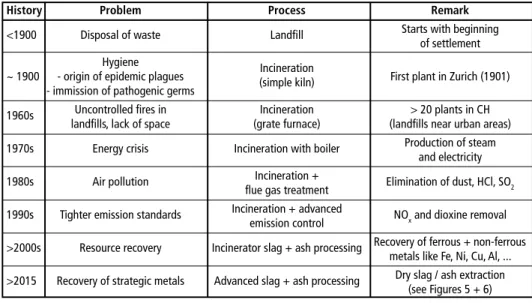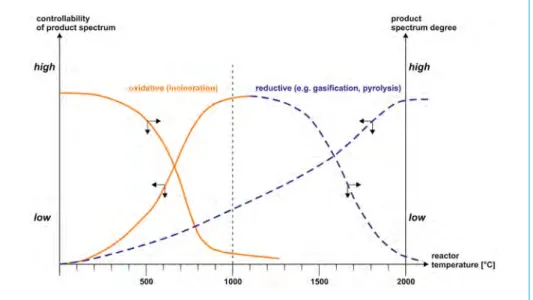Incineration – an Indispensable Element of a Responsible Waste Management
Luciano Pelloni
1. Introduction ...41
1.1. What is waste? ...41
1.2. Goals of waste management: example from Switzerland...42
1.3. Limits of recycling ...42
2. Evolution of waste disposal processes ...44
2.1. History of waste disposal in Switzerland ...44
2.2. Selection of technology for thermal waste treatment ...45
2.3. Advanced resource recovery ...46
3. Conclusion ...47
4. References ...47
On the basis of the example of the implementation Swiss waste management concept it is shown that with simple goals and set environmental boundary conditions, reliable and sustainable solutions can be developed and realized. Hereby, incineration plays a central role and has evolved to the best available technology for the thermal treatment of waste. It became an indispensable element to solve the main problems related to waste, which comprise the reduction of waste volume, preventing from pathogenic hazards, protecting of the environment and the recovery of resources. Considering the future, with waste incineration it will be possible to extract rare substances from waste including strategic metals.
1. Introduction 1.1. What is waste?
This question may be answered in different ways, according to the political, legal or ideological aims of the authors, who define what waste is or has to be. In order to keep things simple in this paper, waste shall be defined as material, which has no value for its producer.
Looking at the different laws and regulations around waste, one common aspect will occur, namely that handling waste implies costs. Hence, the definition stated above can be extended as follows:
Waste is material, which has no or a negative value for its producer.
In the case of negative value this means, that the producer is forced to get rid of the waste: either because it affects his environment or the environment of others. The legal restrictions in this context attribute the costs for the disposal of the waste.
1.2. Goals of waste management: example from Switzerland
A feasible and well-proven guideline was stated by the Swiss government in 1986 [5], where the following goals - among others - were derived:
• A waste management system produces only two categories of substances: re-usable material and material for final repository.
• Waste treatment shall concentrate environmentally harmful material and convert environmentally compatible material into an earth crust- or soil-like form.
These goals are still valid. They led to pragmatic and sustainable solutions. Figure 1 shows this simple but effective concept.
The technical solution was evolved and resulted in the still actual waste manage- ment system in Switzerland. One central element consists of a network of presently thirty waste incineration plants, which treat one hundred percent of residual do- mestic waste, at present about 3.8 million tons per year. Landfills are only used for the disposal of the residues from waste incineration or inert wastes which fulfil the above mentioned goals.
Figure 1: B a s i c c on c e pt of w a s t e management
1.3. Limits of recycling
As a matter of course, one should primarily prevent the production of waste, and re- use would be the next desirable process. But its application has limits. There are three reasons for it: The social, chemical/physical and economic aspect.
• Social aspect
Humans prefer fresh resources and do in general not like used things. Several thousand years ago, hunters and gatherers did produce waste, even if they used the maximum they could from the animals they killed and the fruits and herbs they collected. This was the model for the utopian experiment in Oracle, Arizona USA called Biosphere 2:
In the 1990’s a complete sealed greenhouse-like system on 15,000 m2 was built, in order
to prove that men can live in it without any external supply of material and energy. The first project failed mainly because of technical and environmental reasons. About one year later, an improved Biosphere 2 was started. Despite a sophisticated preparation of this experiment some basic nutrients could not be completely recovered. This expe- riment was shut down, finally because of conflicts and finally some stalwart fights for food which became scarce.
• Chemical/physical aspect
It is evident that every chemical process never produces a yield of one hundred per- cent. There will always be a residual of input substance and an output of undesired by-products.
• Economic aspect
Derived from the fact of never reaching a one hundred percent - yield, the by-products must be treated in order to either get a marketable product or to convert them into a disposable form in compliance with the regulations. Obviously, the borderline between positive and negative value of the by-products is variable and depends on market conditions and regulations.
Figure 2 summarizes the former two findings and depicts the general paths of material in a usage process. Raw material (R) and/or energy are processed, leading to a product with higher value and lower entropy. In general there is a by-product with higher en- tropy and lower value. If the value is negative – in our terms waste – it will be stocked and/or it dissipates into the soil, the water body or the atmosphere. The latter is the case for virtually all natural and industrial processes.
The subsequent re-use and recycle processes start with the (stocked) waste as raw ma- terial. Refining the latter with additives and/or energy produces valuable goods. This means that a valuable resource is recovered from waste. Again, there are by-products
cycles
entropy value
high
low
waste
waste
waste
product
product
product
R
+ –
Figure 2: General path of material and its usage
which partially dissipate like in the first usage cycle. This procedure could be repeated as long as the economic balance is positive. As the spread for profit decreases (dotted curve), the number of usage cycles is limited. Hence, there will always remain a residue which has to be purged.
2. Evolution of waste disposal processes 2.1. History of waste disposal in Switzerland
Table 1 summarizes the history of how waste disposal were solved in Switzerland.
With the increasing settlement and civilization waste became a ubiquitous source of irritation. Landfills were situated almost in the backyards – it has to be mentioned that due to the alpine character of the country only about forty percent of the land area is available for settlement and agriculture.
Self ignition of waste in the discharges led to smoke clouds near inhabited areas. This led to the solution to build plants with controlled combustion: incineration plants.
Soon, recovery of energy was integrated. Air pollution control regulations brought the plants to a highly sophisticated standard what enables to operate plants which are situated within town limits in inhabited areas – e.g. Zurich, Berne, Lausanne, Geneva, Saint Gall, Winterthur.
With the increasing market prices of basic materials, recovery of metals from the residuals of waste incineration plants became attractive. The waste incineration plant nowadays has two functions: as mean for waste disposal and a mean for resource recovery from waste.
Table 1: History of solutions for waste disposal in Switzerland
History Problem Process Remark
<1900 Disposal of waste Landfill Starts with beginning
of settlement
Hygiene Incineration
~ 1900 - origin of epidemic plagues (simple kiln) First plant in Zurich (1901) - immission of pathogenic germs
1960s Uncontrolled fires in Incineration > 20 plants in CH
landfills, lack of space (grate furnace) (landfills near urban areas)
1970s Energy crisis Incineration with boiler Production of steam
and electricity
1980s Air pollution Incineration + Elimination of dust, HCl, SO2
flue gas treatment
1990s Tighter emission standards Incineration + advanced NOx and dioxine removal emission control
>2000s Resource recovery Incinerator slag + ash processing Recovery of ferrous + non-ferrous metals like Fe, Ni, Cu, Al, ...
>2015 Recovery of strategic metals Advanced slag + ash processing Dry slag / ash extraction (see Figures 5 + 6)
2.2. Selection of technology for thermal waste treatment
As shown with the example in chapter 2.1, the solution for reduction of volume and for minimizing hygienic hazards is the thermal treatment of the waste. In the last fifty to sixty years it was proposed again and again to apply reductive thermal treatment such as gasification, pyrolysis or plasma treatment. So-called innovative processes were promoted, with nomination as clean technology with zero emission and producing synthetic fuel, etc. The fact is that none of such processes fulfilled the promised goals until today [2].
Incineration is the best available technology because the final products of the com- bustion are not further reactive. The goal of waste disposal to bring the waste into a chemically and physically stable form is fulfilled as the organic part is eliminated. This is not possible with a reductive process.
Figure 3 shows a comparison of the oxidative process – incineration – and the reductive process (pyrolysis/gasification/plasma).
The reductive process is basically a cracking process. This means that in absence of oxygen the organic components dissociate when heated up. The resulting products from these reactions at temperatures up to approximately 1,500 °C may reconvert or dissociate further. This is the reason why the spectrum of the products from this process is not predictable and hence not controllable in the temperature range below 1,500 °C.
Only at temperatures well above 1,800 °C the spectrum becomes tight.
For the incineration as an oxidative process, about 900 °C to 1,100 °C are sufficient for a reliable control of the product spectrum, depending on the furnace system. This is the basic high advantage of the incineration compared to reductive processes.
Figure 3: Thermal waste treatment: comparison of oxidative and reductive processes
2.3. Advanced resource recovery
Processing of slag and ash from the incineration process produces valuable raw material such as iron, alumina, copper, zinc. In few years, the newest generation of plants will comprise installations for the recovery of trace metals such as platinum, gold, silver.
In the near future, metals like rare earths, rhodium, niobium, palladium will become of strategic importance (Figure 4). The billions of devices for communication and enter- tainment contain traces of these substances which sum up to considerable mass. It will be almost impossible to extract the trace metals from these components manually or by mechanical means. The best solution is to eliminate all the plastic, i.e. organic part and extract these metals from the residuals which with combustion result in a mineral form.
Figure 4:
Strategic elements in context with restrictions and availability
Sources:
NRC Minerals (2008), Critical Minerals and the U.S. Economy
Schluep, M.; (2013, October): Actual challenge in Resource Recovery, Waste Management Event of Switzerland Glo- bal Enterprise, 30.10.2013 in Zurich, Switzerland; with specific reference to NRC Minerals
The new generation of incineration plants has the additional goal: enable the extraction of trace metals from the residuals of incineration. The basic concept is to implement a so-called dry extraction of the slag and fly ash. The second step is a process with several sieving, magnetic and eddy current separation (Figures 5 and 6). The technical feasibility has been proved [1].
Figure 5:
Scheme of dry slag/ash extraction
This advanced process can be split after the dry extraction. The dry residues are subse- quently transferred to a central processing plant which serves also other incineration plants with dry extraction. Such a plant is actually in realization in Hinwil, Canton of Zurich, Switzerland.
3. Conclusion
The main problems of waste disposal comprise reduction of volume, preventing from pathogenic hazards, protecting of the environment and the recovery of resources. Inci- neration has evolved as best available solution with manifold proven installations world -wide. The basic concept was designed more than one hundred years ago. Analogous to the car engine of 1900, the today’s technology has developed to a sophisticated treatment process. It fulfils highly demanding environmental standards and enables the recovery of valuable material and in the future also rare substances such as strategic metals.
4. References
[1] Böni, D. (2012, November). Urban Mining konkret, Thermo-Recycling. Speech presented at VGB Fachtagung Thermische Abfallbehandlung, Hürth, Germany.
[2] ISWA Working Group on Energy Recovery (2013): Alternative Waste Conversion Technologies, White Paper, January 2013
[3] NRC Minerals (2008), Critical Minerals and the U.S. Economy
[4] Schluep, M.; (2013, October): Actual challenge in Resource Recovery, Waste Management Event of Switzerland Global Enterprise, 30.10.2013 in Zurich, Switzerland; with specific reference to[3]
[5] Swiss Federal Authority for Environmental Protection (1986): Guideline for the Swiss Waste Management, Berne, June 1986
Figure 6:
Separation processes for ad- vanced recovery of metals


